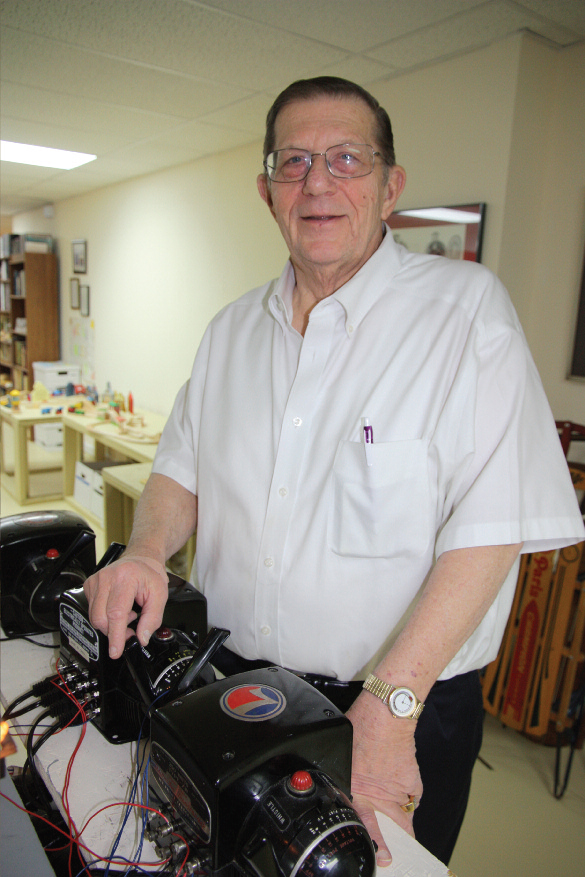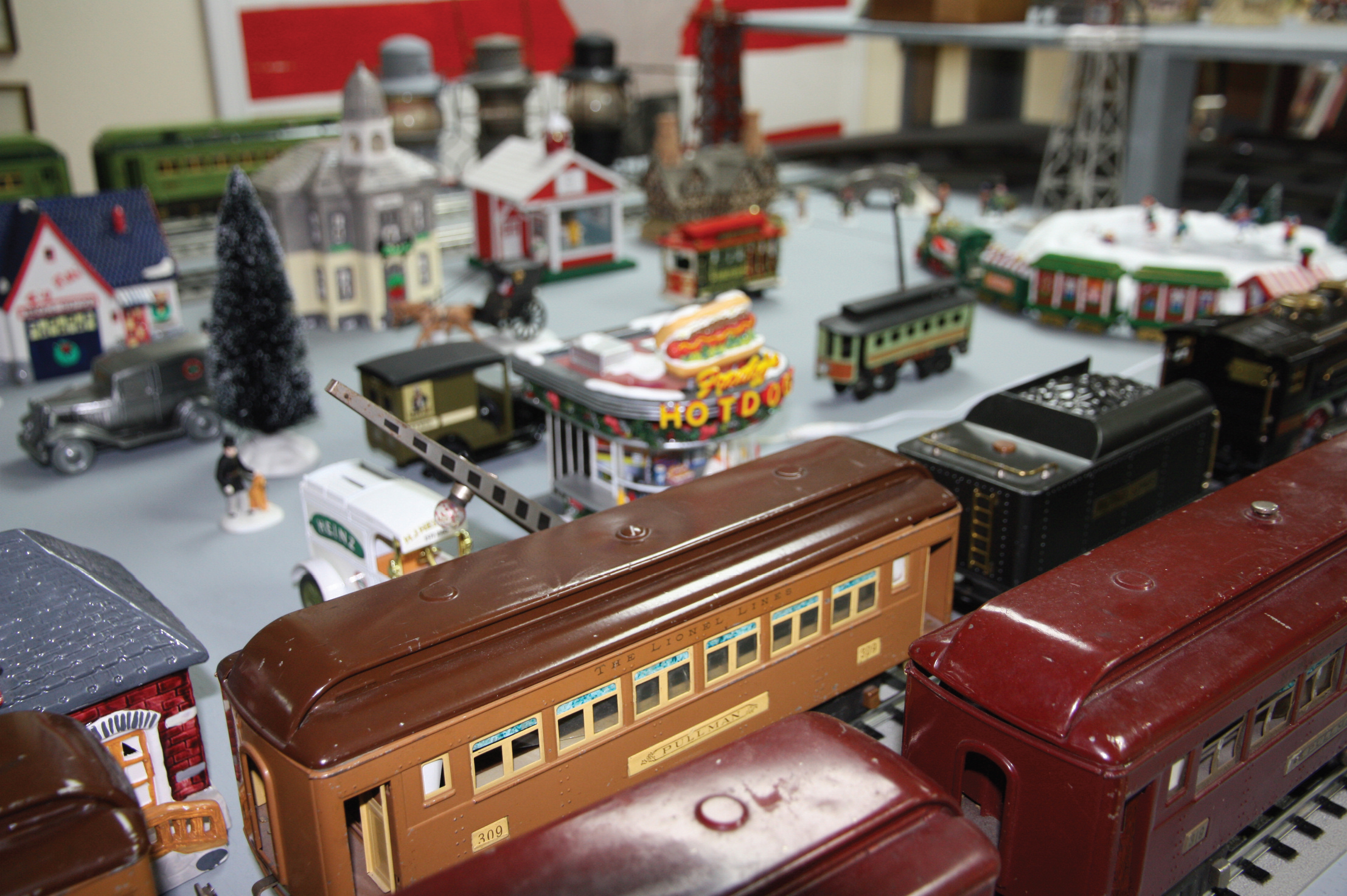Not My Day Job: Model Behavior
 Dr. Frank Spreng loses track of time working on his model railroad, which takes up
nearly half of his home’s finished basement.
Dr. Frank Spreng loses track of time working on his model railroad, which takes up
nearly half of his home’s finished basement.
“There are times I come down here at 8 o’clock at night and before I know it, it’s
1 a.m.,” said the economics professor and director of McKendree’s MBA program. He operates 10 trains, including two standard gauge and six O gauge models of his
youth, on a 17 x 16-foot platform with a 6 x 12-foot extension. As a model railroad
hobbyist Frank is part historian, engineer, city planner, mechanic, electrician, landscaper
and miniature props master.
Growing up in Pittsburgh, Penn. his first train was a pre-owned standard gauge electric
steam engine model manufactured in the 1930s. “My uncle bought it from a guy who worked
for him,” he said.
His sentimental favorites are the Santa Fe and Southern Pacific trains received as
gifts in the fourth or fifth grade. “They were bought for me, pure and simple,” he
said, showing the original five railcars. “This is how they would have come out of
the box.”
Frank eventually put aside the trains of his childhood to join the high school debate
team. Many years later in mid-career, married with a family and teaching in Kentucky,
he unpacked them to enjoy once more. When the Sprengs moved from Belleville, Ill.
to their new home in Shiloh, Ill., a few years ago, everything old became new again.
At last Frank had plenty of space and the chance to design a permanent layout from
the ground up, large enough to accommodate his collection.
"IT’S A WORK IN PROGRESS. I HAVE A PLAN AND IT’S NOT COMPLETELY HAPHAZARD."
 “It was like an empty shell. Two guys built the platform over three days. It’s built
like a foundation for a house. Its original purpose was to display the older trains,
most of what I had as a child. My first effort was to get the trains running and the
tracks laid. My goal was to get the longest run for the five trains on the outer track.
“It was like an empty shell. Two guys built the platform over three days. It’s built
like a foundation for a house. Its original purpose was to display the older trains,
most of what I had as a child. My first effort was to get the trains running and the
tracks laid. My goal was to get the longest run for the five trains on the outer track.
“It’s a work in progress. I have a plan and it’s not completely haphazard,” he said,
referring to a schematic diagram on the wall.
Each train has a story. Frank pointed to a replica of the Pennsylvania Railroad’s
Congressional Limited passenger train in the staging yard. “That was an elegant train
that ran commuters from Washington, D.C. to New York City. It ran on an overhead catenary
system of electrified lines after the demise of steam engines due to pollution.”
A Lionel streamliner from the 1954 catalog features a “vista dome” car with a skylight
that offered passengers on the real thing a panoramic overhead view. “That would have
been a fancy train trip in the 40s or 50s.”
A freight train reflects his western Pennsylvania roots. Boxcars bear the logos of
Heinz Pickles, Danceland, Isaly’s Coffee, Foodland, the Steelers football team and
famous groundhog Punxsutawney Phil. A flatcar carries miniature Pittsburgh Steel girders.
A more recent addition, the Polar Express, is a favorite of the Sprengs’ three young
grandchildren, who play with their own toy trains on a lower 3 x 12-foot platform
they can easily reach.
A train whistle interrupts the rumbling sound of wheels in motion as Frank operates
the low voltage transformers that power each locomotive. The switches are the most
challenging to keep working and derailments do happen, he admits, even on the FasTrack
system he bought four years ago. “I was told, ‘Don’t even try to use old track.’ It
gets rusty,” he said.
He will be able to devote more time to his hobby when he retires from his full-time
position this spring. He plans to add an industrial area, farm, river, gully, cabin
and an elevated track to connect a western frontier scene to another platform. An
English village of cottages and castles, a reminder of the Sprengs’ years in London,
awaits completion.
FRANK IS NOT MCKENDREE’S ONLY MODEL RAILROADER...
Frank is not McKendree’s only model railroader. Dr. Joe Cipfl, dean of the graduate
program, keeps a train set at his Ozarks lake home. Victoria Dowling, senior vice
president and her son Daniel, have a room in their basement dedicated to an HO scale
train layout. Dr. Timothy Richards, associate professor of education, tells a story
similar to Frank’s.
“When I was eight years old, my father bought me an S scale American Flyer freight
set which was put under the Christmas tree each year. I still have the set and it
still runs. I currently only run the O scale trains, but I hope to add another layout
dedicated to the two G-scale trains I have. G scale requires much space.”
An 8 x 24-foot layout in his basement features a residential street, a downtown and
a countryside. “I keep the layout up all year long so that I can add or make changes,”
said Tim. “You are never finished building a train layout because you are always getting
new ideas from train magazines and train shows.”
